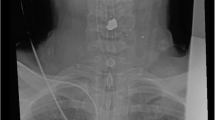Abstract
Objective
The main objective of this study was to present a case of gunshot injury in which a bullet particle settled into the inferior-thoracic epidural canal, which was neurologically intact, without causing any vertebral bone destruction.
Summary of background data
There has been no previous report in the literature regarding a foreign body settling into the vertebral canal following gunshot injury without causing any bony destruction.
Case report
A 40-year-old male patient was hospitalized in emergency service with the complaints of severe pain in his back and both legs secondary to a gunshot wound. The entrance wound of the traversing projectile was located at the level of the tenth costa at the inferior of the right scapula. Neurological examination revealed no motor deficit. His lung X-ray was normal at radiological examination. Direct radiograph determined a bullet nucleus on the medium line at thoracolumbar level T-12. Intracanalicular bullet nucleus was found at posterior epidural at the T-12 level on thoracic CT, myelography and CT myelography. No vertebral bone destruction was seen in the direct radiograph studies and serial CT. T12 total laminectomy was performed and epidural foreign body removed. The patient, whose pains ameliorated during the postoperative process, was discharged without any neurological deficit.
Conclusion
We prefer removal of firearm particles settling into the spinal canal in view of possible later complications such as infection and the toxic effect of the metallic particles, unless there appears any risk of neurological detriment to the patient.







Similar content being viewed by others
References
Go BK, Devivo MJ, Richards JS (1995) The epidemiology of spinal cord injury. In: Stover SL, Delisa JA, Whiteneck GG (eds) Spinal cord injury: clinical outcomes from the model systems. Apsen, Gaithersburg, pp 21–55
Marino RJ (2003) Spinal injury: etiology, demographics, and outcomes. In: Vaccaro AR (ed) Fractures of the cervical, thoracic and lumbar spine, 1st edn. Marcel Dekker, New York pp 3
Lin SS, Vaccaro AR, Reisch S et al (1995) Low velocity gunshot wounds to the spine with an associated transperitoneal injury. J Spinal Disord 8:136–144
Isiklar ZU, Lindsey RW (1998) Gunshot wounds to the spine. Injury 29:7–12
Mirovsky Y, Salmon E, Blankstein A, Halperin N (2005) Complete paraplegia following gunshot injury without direct trauma to the cord. Spine 30(21):2436–2438
Koizumi M, Ueda Y, Lida J, Matsuyama E, Yoshikawa T, Takakura Y, Hirai T, Murakami J (2002) Upper thoracic spinal cord injury without vertebral bony lesion: a report of two cases. Spine 27(21):467–470
Fager CA (1989) Atlas of spinal surgery. Lea & Febiger, London, pp 201–213
De Muth WE Jr (1969) Bullet velocity as applied to military rifle wounding capacity. J Trauma 9:27–38
De Muth WE Jr (1966) Bullet velocity and design as determinants of wounding capability: an experimental study. J Trauma 6:222–232
Charters III AC, Charters AC (1976) Wounding mechanism of very high velocity projectiles. J Trauma 16:464–470
Hopkinson DA, Marshall TK (1967) Firearm injuries. Br J Surg 54:344–353
Russoti GM, Sim FH (1985) Missile wounds of the extremities: a current concepts review. Orthopedics 8:1106–1116
Robertson DP, Simpson RK, Narayan RK (1991) Lumbar disc herniation from a gunshot wound to the spine. A report of two cases. Spine 16:994–995
Meyer PR, Apple DF, Bohlman HH, Ferguson RL, Stauffer ES (1988) Symposium: management of fractures of the thoracolumbar spine. Contemp Orthop 16:57–86
Yoshida GM, Garland D, Waters RL (1995) Gunshot wounds to the spine. Orthop Clin North Am 26:109–116
Waters LR, Sie H (2003) Spinal cord injuries from gunshot wounds to the spine. Clin Orthop Rel Res 408:120–125
Arasil E, Tascioğlu AO (1982) Spontaneous migration of an intracranial bullet to the cervical spinal canal causing Lhermitte’s sign: case report. J Neurosurg 56:158–159
Jones FD, Woosley RE (1981) Delayed myelopathy secondary to retained intraspinal metallic fragment. J Neurosurg 55:979–982
Karim NO, Nabors MW, Golocovsky M, Cooney FD (1986) Spontaneous migration of a bullet in the spinal subarachnoid space causing delayed radicular symptoms. Neurosurgery 18:97–100
Soges LJ, Kinnebrew GH, Limcaco OG (1988) Mobile intrathecal bullet causing delayed radicular symptoms. Am J Neuroradiol 9:610
Wu WQ (1986) Delayed effects of retained foreign bodies in the spine and spinal cord. Surg Neurol 25:214–218
Roffi RP, Waters RL, Adkins RH (1989) Gunshot wounds to the spine associated with a perforated viscus. Spine 14:808–811
Dillman RO, Crumb CK, Lidsky MJ (1979) Lead poisoning from a gunshot wound: report of a case and review of the literature. Am J Med 66:509–514
Switz DM, Elmorshidy ME, Deyerle WM (1976) Bullets, joints, and lead intoxication: a remarkable and instructive case. Arch Intern Med 136:939–941
Graef JW, Lovejoy FH (1987) Heavy metal poisoning. In: Wilson JD, Braunwald E, Isselbacher KJ et al (eds) Harrison’s principles of internal medicine, vol 2, 12th edn. McGraw-Hill, New York, pp 2182–2186
Richards JS (1988) Pain secondary to gunshot wound during the initial rehabilitation process in spinal cord injury patients. J Rehab Res Rev 25(Suppl):75–77
Richards JS, Meredith RL, Nepomuceno C, Fine PR, Bennett G (1980) Psychosocial aspects of chronic pain in spinal cord injury. Pain 8:355–366
Waters RL, Adkins RH (1991) The effects of removal of bullet fragments retained in the spinal canal: a collaborative study by the national spinal cord injury model systems. Spine 16:934–939
Author information
Authors and Affiliations
Corresponding author
Rights and permissions
About this article
Cite this article
Kalkan, E., Keskin, F., Cengiz, Ş.L. et al. A case report of firearm bullet settling into the thoracic spinal canal without causing neurological deficit or vertebral bone destruction. Arch Orthop Trauma Surg 127, 637–641 (2007). https://doi.org/10.1007/s00402-007-0307-x
Received:
Published:
Issue Date:
DOI: https://doi.org/10.1007/s00402-007-0307-x




